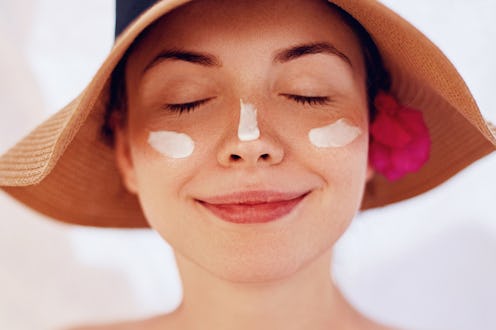Life
5 Ways You're Making Your Sunscreen Less Effective Without Even Realising

Remembering to apply sunscreen multiple times a day can be a bit of a pain, but it's a vital step in the prevention of burning and deeper skin damage. Staying safe in the sun, however, isn't as simple as a quick spray two minutes before you leave the house or hotel. It unfortunately requires a little more effort. If you're not taking sufficient time to apply it correctly, you're probably making your sunscreen less effective.
Before getting into the nitty gritty application details, you need to ensure you're using an adequate formula. According to the NHS, a good sunscreen will have an SPF of at least 15 and a minimum four-star UVA protection rating. And don't forget to check your bottle isn't past its expiry date. (It happens, believe me.)
Sunscreen problems occur when you don't apply enough sunscreen, apply it unevenly, or accidentally dilute it. Choosing one with a higher SPF is therefore likely to give you more protection. In fact, a 2017 survey of 165 dermatologists, published in JAMA Dermatology, found that 97 percent of dermatologists recommended using SPF 50 or higher.
However, using a lesser SPF will be fine as long as you avoid the following common pitfalls. It's time for some re-education.
1Mixing It With Fake Tan
Although you can get a tan from (safely) sunbathing, many yearn for a glow pre-holiday. But fake tanning and sunscreen do not mix. At all. As Abi Cleeve, founder of Ultrasun, told Refinery29: "DHA (the active ingredient in fake tan which makes skin brown) really undermines UVA protection."
If you're still getting to grips with your UVA and UVB rays, the former can result in lines, wrinkles, and skin cancer while the latter is what burns the skin, states the World Health Organisation. Essentially, you may not burn with a combination of sunscreen and fake tan, but you could risk your health.
2Applying Skincare Products On Top
There is some debate among dermatologists as to whether you should apply sunscreen before or after moisturiser. But more seem to believe that it should go on last. "When moisturiser is applied after sunscreen, it can actually change the properties of your sunscreen," dermatologist Sejal Shah told Allure. "It can also alter the way that UV rays meet your skin."
It's also important to keep foundation or other makeup separate from sunscreen. Mixing the two together may dilute the SPF, dermatologist Mona Gohara explained to Well+Good. "Layering ensures that each maintains its power,” Gohara said.
3Not Applying Enough
Whether you use a spray or cream, you're probably not applying enough sunscreen. Ensuring every inch of visible skin is covered in an even layer is essential. It's not easy, but it will protect you. The NHS advises adults to apply two teaspoons' worth if just covering the head, arms, and neck. But if you're sunbathing in a swimsuit, up that to two tablespoons to adequately cover your entire body, the NHS states.
For sprays, you should be spraying each part of your body for six seconds and rubbing in afterwards, reports the Independent. Apparently, the majority of people only do it for two, so it may not come naturally.
Last but not least, sticks (which are often used on the face) should be applied all over at least twice, the Independent states. And don't forget your ears and eyelids.
Make sure you wait at least 20 minutes before going outside. This will give the active synthetic ingredients a chance to work their magic, states skincare brand Paula's Choice.
4Missing Vital Parts Of Your Skin
A recent study, published in PLOS One, found that people were tending to miss 11 percent of their face when applying sunscreen. Typically, participants left out the area around the eyes and on the eyelids. It's rather worrying as these areas have pretty thin skin and are therefore more susceptible to sun damage.
Other places commonly missed are the ears, lips, hands, neck, and feet, reports Reader's Digest. Oh, and don't forget to spritz your scalp too, because sunburn on the top of your head damn well hurts.
5Forgetting To Reapply
So you've applied your sunscreen perfectly and have been catching some rays for a few hours. What have you forgotten to do? Re-apply.
Johnson & Johnson recommends re-applying sunscreen every two hours to stay safe. If you go swimming, re-apply as soon as you get out of the water. The same goes for any sweaty scenarios.
Another thing to note is that towels and sunscreen are not friends. "There’s no such thing as a completely towel-proof sunscreen, so as you dry off, you’re most likely removing what’s on your skin," notes Joshua D. Williams, principal scientist at Johnson & Johnson. How do you fix the problem? You guessed it. Re-apply.
6
Better get up a few minutes earlier this summer, and start applying that sunscreen ASAP.